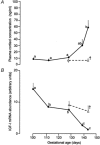Control of growth hormone receptor and insulin-like growth factor-I expression by cortisol in ovine fetal skeletal muscle
- PMID: 12042362
- PMCID: PMC2290344
- DOI: 10.1113/jphysiol.2002.016402
Control of growth hormone receptor and insulin-like growth factor-I expression by cortisol in ovine fetal skeletal muscle
Abstract
Insulin-like growth factor (IGF)-I has an important role in myogenesis but its developmental regulation in skeletal muscle before birth remains unknown. In other tissues, cortisol modulates IGF gene expression and is responsible for many of the prepartum maturational changes essential for neonatal survival. Hence, using RNase protection assays and ovine riboprobes, expression of the IGF-I and growth hormone receptor (GHR) genes was examined in ovine skeletal muscle during late gestation and after experimental manipulation of fetal plasma cortisol levels by fetal adrenalectomy and exogenous cortisol infusion. Muscle IGF-I, but not GHR, mRNA abundance decreased with increasing gestational age in parallel with the prepartum rise in plasma cortisol. Abolition of this cortisol surge by fetal adrenalectomy prevented the prepartum fall in muscle IGF-I mRNA abundance. Conversely, raising cortisol levels by exogenous infusion earlier in gestation prematurely lowered muscle IGF-I mRNA abundance but had no effect on GHR mRNA. When all data were combined, plasma cortisol and muscle IGF-I mRNA abundance were inversely correlated in individual fetuses. Cortisol is, therefore, a developmental regulator of IGF-I gene expression and is responsible for suppressing expression of this gene in ovine skeletal muscle near term. These observations have important implications for muscle development both before and after birth, particularly during conditions which alter intrauterine cortisol exposure.
Figures





 , cortisol infused adrenalectomized fetuses. All animals, log10y = 1.479-[0.688 log10x], n = 37, r = −0.761, P < 0.001; control animals alone, log10y = 1.580 − [0.760 log10x], n = 19, r = −0.805, P < 0.001).
, cortisol infused adrenalectomized fetuses. All animals, log10y = 1.479-[0.688 log10x], n = 37, r = −0.761, P < 0.001; control animals alone, log10y = 1.580 − [0.760 log10x], n = 19, r = −0.805, P < 0.001).Similar articles
-
Thyroid hormones and the mRNA of the GH receptor and IGFs in skeletal muscle of fetal sheep.Am J Physiol Endocrinol Metab. 2002 Jan;282(1):E80-6. doi: 10.1152/ajpendo.00284.2001. Am J Physiol Endocrinol Metab. 2002. PMID: 11739087
-
The ontogeny of hepatic growth hormone receptor and insulin-like growth factor I gene expression in the sheep fetus during late gestation: developmental regulation by cortisol.Endocrinology. 1996 May;137(5):1650-7. doi: 10.1210/endo.137.5.8612497. Endocrinology. 1996. PMID: 8612497
-
Activation of the adult mode of ovine growth hormone receptor gene expression by cortisol during late fetal development.FASEB J. 1999 Mar;13(3):545-52. doi: 10.1096/fasebj.13.3.545. FASEB J. 1999. PMID: 10064621
-
Growth hormone and the insulin-like growth factor system in myogenesis.Endocr Rev. 1996 Oct;17(5):481-517. doi: 10.1210/edrv-17-5-481. Endocr Rev. 1996. PMID: 8897022 Review.
-
Ontogeny and nutritional manipulation of the hepatic prolactin-growth hormone-insulin-like growth factor axis in the ovine fetus and in neonate and juvenile sheep.Proc Nutr Soc. 2004 Feb;63(1):127-35. doi: 10.1079/PNS2003324. Proc Nutr Soc. 2004. PMID: 15070443 Review.
Cited by
-
IUGR impairs cardiomyocyte growth and maturation in fetal sheep.J Endocrinol. 2018 Oct 16;239(2):253-265. doi: 10.1530/JOE-18-0382. Print 2018 Nov 1. J Endocrinol. 2018. PMID: 30143557 Free PMC article.
-
Brown to White Fat Transition Overlap With Skeletal Muscle During Development of Larger Mammals: Is it a Coincidence?J Endocr Soc. 2022 Sep 27;6(12):bvac151. doi: 10.1210/jendso/bvac151. eCollection 2022 Oct 26. J Endocr Soc. 2022. PMID: 36325536 Free PMC article. Review.
-
Effects of cortisol and dexamethasone on insulin signalling pathways in skeletal muscle of the ovine fetus during late gestation.PLoS One. 2012;7(12):e52363. doi: 10.1371/journal.pone.0052363. Epub 2012 Dec 26. PLoS One. 2012. PMID: 23300651 Free PMC article.
-
Loss of the pregnancy-induced rise in cortisol concentrations in the ewe impairs the fetal insulin-like growth factor axis.Reprod Fertil Dev. 2011;23(5):665-72. doi: 10.1071/RD10317. Reprod Fertil Dev. 2011. PMID: 21635815 Free PMC article.
-
Serum cortisol and insulin-like growth factor 1 levels in major depressive disorder and schizophrenia.Sci Rep. 2023 Jan 20;13(1):1148. doi: 10.1038/s41598-023-28449-8. Sci Rep. 2023. PMID: 36670169 Free PMC article.
References
-
- Adams TE. Differential expression of growth hormone receptor messenger RNA from a second promoter. Molecular and Cellular Endocrinology. 1995;108:23–33. - PubMed
-
- Aldoretta PW, Carver TD, Hay WW. Maturation of glucose-stimulated insulin secretion in fetal sheep. Biology of the Neonate. 1998;73:375–386. - PubMed
-
- Armitage P. Statistical Methods in Medical Research. Oxford: Blackwells; 1971.
-
- Ashmore CR, Robinson DW, Rattray P, Doerr I. Biphasic development of muscle fibres in the fetal lamb. Experimental Neurology. 1972;37:241–255. - PubMed
-
- Boyle DW, Denne SC, Moorehead H, Lee W-H, Bowsher RR, Lichty EA. Effect of rhIGF-I on whole fetal and fetal skeletal muscle protein metabolism in sheep. American Journal of Physiology. 1998;275:E1082–1091. - PubMed
Publication types
MeSH terms
Substances
LinkOut - more resources
Full Text Sources

